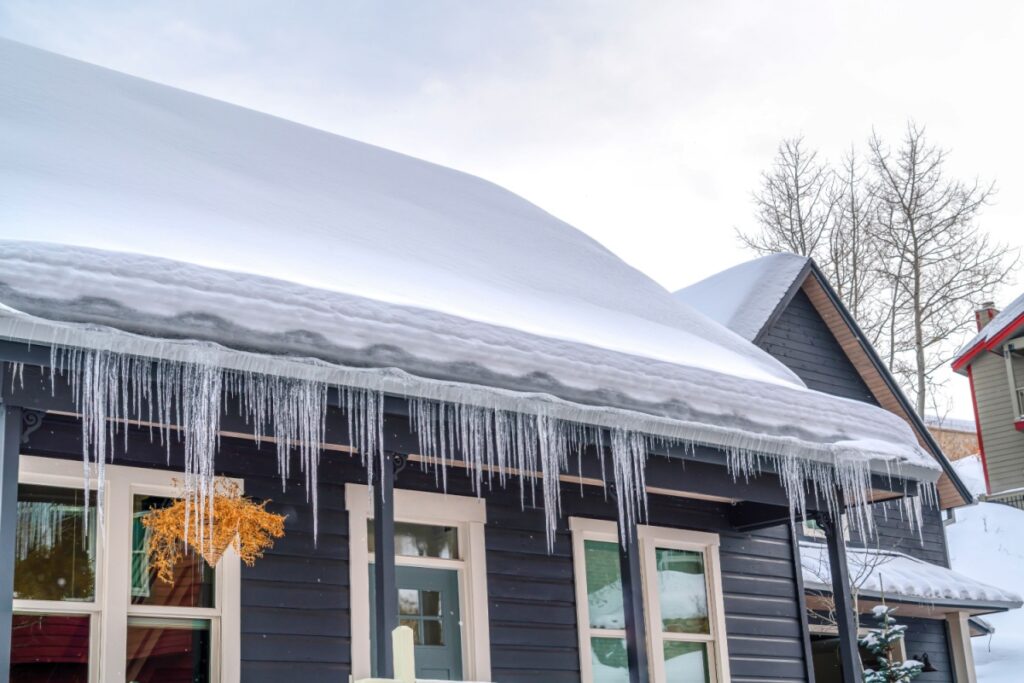
How does snow and ice impact your roof? That’s a great question! At first blush, it may not seem like these elements can do a whole lot to your roof — after all, the materials were designed to withstand the weather, right? Well, while this is true, snow and ice can eventually cause serious issues, especially if the roof is older or the storm is particularly heavy. Make sure you understand the full impact of snow and ice on your roof (such as damage from extensive weight or moisture problems due to ice dams) so you can avoid costly repairs in the future.
How Snow and Ice Impact Your Roof
Queens, NY, is no stranger to snow and ice storms. Unfortunately, this means homeowners frequently have to deal with a range of roofing issues due to the harsh effects of winter weather. Some of the problems you may experience include:
Heavy Snow Load
One of the biggest concerns with snow and ice is the sheer weight they add to your roof. A single inch of snow doesn’t weigh much, but as it accumulates, the pounds start stacking up.
If too much weight builds up, your roof may begin to sag, leading to long-term structural damage and, in extreme cases, even collapse. Homes with older or weaker roofs are particularly vulnerable to this type of stress.
Ice Dams
Ice dams are another major issue that arises when snow and ice accumulate on your roof. When snow melts due to heat escaping from your home, the water runs down your roof and refreezes at the edges. This creates a barrier, or ice dam, that prevents additional melting snow from properly draining off your roof. Instead, the trapped water backs up under the shingles, leading to leaks and interior water damage. Over time, this water infiltration can compromise insulation, stain ceilings, and even lead to mold growth inside your home.
Effects of the Freeze-Thaw Cycle
As snow and ice melt, water can seep into small cracks in your shingles, flashing, or roof decking. When temperatures drop again, the water refreezes and expands, making those cracks larger. Over time, this process weakens roofing materials and can cause shingles to loosen, break, or fall off entirely. This type of damage may not always be visible from the ground, but it can severely impact the lifespan of your roof.
Gutter Issues
Gutters also take a beating during the winter months. The weight of ice buildup and compacted snow can pull gutters away from the roofline, causing them to sag or even detach completely. Also, clogged or frozen gutters can lead to improper drainage, which increases the likelihood of water pooling on your roof and finding its way into your home. Keeping gutters clear is essential for preventing excess moisture buildup and reducing the risks of snow and ice damage.
How to Protect Your Roof From Snow and Ice Damage
You don’t have to sit and wait for the next winter storm to blow in and hope for the best. You can take steps to prevent snow and ice damage now and save yourself from a world of headaches in the future.
Improve Insulation & Ventilation
One of the best ways to prevent snow and ice from damaging your roof is to ensure your attic is properly insulated and ventilated. Good insulation prevents excessive heat from escaping through the roof, which minimizes snow melt and reduces the risk of ice dam formations.
Proper ventilation also helps regulate temperature and moisture levels. This, in turn, prevents condensation from building up inside your attic and weakening the roof structure.
Prioritize Roofing Maintenance
Before winter arrives, have a professional roofing company inspect your roof for any weak spots, damaged shingles, or areas of concern. Addressing these issues proactively can help prevent leaks and structural damage once the snow starts to fall. Additionally, keeping your gutters clean and free of debris ensures proper drainage, reducing the likelihood of ice dams and water infiltration.
Use Heating Cables
Installing heat cables along the edges of your roof can be another effective solution for preventing ice dams. These cables generate enough warmth to keep water flowing off your roof instead of refreezing at the edges. While they don’t solve all winter roofing problems, they can be a valuable tool for homes that are particularly prone to ice dams.
Remove Excess Snow
Removing snow from your roof can also help prevent damage, especially after a major snowstorm. Using a roof rake with a long handle, homeowners can safely remove some of the snow from the edges of their roofs without the risk of climbing onto a slippery surface. However, for heavy snow accumulation or hard-to-reach areas, it’s best to call a professional to avoid injury or accidental damage to your roof.
Lucky Stars Roofing Can Help With Winter Roof Damage
If snow or ice has damaged your roof, there’s no need to panic — Lucky Stars Roofing is just a call away. We specialize in roof repairs and gutter services, and our team will conduct a thorough inspection to pinpoint any issues caused by the effects of snow and ice. Whether it’s repairing leaks, replacing damaged shingles, or fixing sagging gutters, we’ll quickly restore the integrity of your roof and protect your home from further damage.
Connect with our friendly and knowledgeable team today and ensure your home stays safe during heavy snowfall and freezing temperatures!


